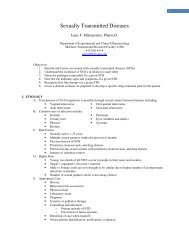The Penicillins
The Penicillins
The Penicillins
Create successful ePaper yourself
Turn your PDF publications into a flip-book with our unique Google optimized e-Paper software.
1. Amoxicillin + clavulanic acid (Augmentin ® - Glaxo-SK)<br />
O<br />
H<br />
C N<br />
O<br />
COOH<br />
Clavulanic acid<br />
38<br />
CH-CH2OH<br />
a. Clavulanic acid extends spectrum to b-lactamase-producing organisms. Inhibits<br />
PC-1 b-lactamase of Staph.aureus and of anaerobic Bacteroides sp.<br />
b. Extended spectrum towards gram negative bacteria. Activity towards<br />
Richmond-Sykes Class II, III, IV, and V b-lactamases. Some Gm – blactamases<br />
are not inhibited (Richmond-Sykes Type I). .<br />
c. Clavulanic acid has some weak antibacterial activity itself. Binds to PBP-2.<br />
Combination with amoxicillin is synergistic for Klebsiella sp.<br />
Indications for Augmentin® are as follows:<br />
• Otitis media, sinusitis, and respiratory tract infections (acute exacerbations of bronchitis or<br />
chronic obstructive pulmonary disease, COPD) due to b-lactamase producing H. influenzae<br />
& Moraxella catarrhalis.<br />
• High strength formulation (Augmentin ES – 90 mg/kg) recently approved for otitis media<br />
due to Strep. pneumoniae<br />
• Skin and Skin-structure infections caused by b-lactamase-producing strains of Staph.<br />
aureus, E. coli, and Klebsiella sp.<br />
• UTIs due to b-lactamase-producing strains of E. coli, Enterobacter sp., and Klebsiella sp<br />
2. Ampicillin + Sulbactam (Unasyn ® -Roerig)<br />
O<br />
C N<br />
O<br />
S<br />
Sulbactam<br />
O<br />
CH3<br />
CH 3<br />
COOH<br />
a. Similar to Augmentin®, but Unasyn® available for IV use.<br />
b. Sulbactam similar to clavulanic acid. Slightly more active against<br />
cephalosporinases. Less active toward TEM-2 of Enterobacteriaciae.<br />
Indications for Unasyn® are:<br />
i. Skin & soft tissue infections due to b-lactamase-producing strains of Staph.<br />
aureus, E. coli, and Klebsiella sp., Proteus mirabilis, Bacteroides fragilis,<br />
Enterobacter sp., and Acinetobacter calcoceticus.




